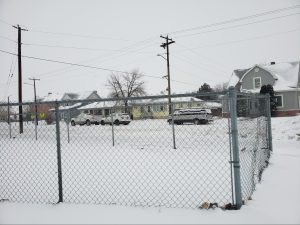No products in the cart.

Welcome to the world of DIY chain-link fence installation, where you can take control of your property’s security and aesthetics. Are you ready to embark on a journey of creativity, cost-effectiveness, and empowerment? In this guide, we will unveil the secrets to mastering the art of DIY chain-link fence installation. From essential tips and tools to common mistakes and pros and cons, you’ll discover everything you need to create a stunning fence that enhances your property. So grab your tools and let’s dive into this exciting adventure!
When it comes to DIY chain-link fence installation, a solid foundation is key. Before you begin, it’s important to plan and prepare meticulously. Start by determining the exact location and boundaries for your fence. Measure the area accurately, mark the corners, and consider any obstacles or permits required. With a well-thought-out plan in place, you’ll avoid unnecessary setbacks and ensure a smooth installation process.
The Right Tools for the Job
To conquer any project, you need the right tools at your disposal. DIY chain-link fence installation is no exception. Here are some essential tools you’ll need:
With these tools in hand, you’re ready to tackle any challenges that come your way during the installation process.
Before you jump into the installation process, take the time to prepare properly. Clear the area of any vegetation, rocks, or debris. Level the ground to ensure a smooth foundation for your fence. If necessary, contact utility companies to mark any underground lines to avoid accidents during the digging process. Taking these preparatory steps will set the stage for a successful installation.
Setting the Posts
The posts are the backbone of your chain-link fence, providing stability and support. Start by setting the corner posts first. Dig holes that are approximately one-third the height of the post and secure them with concrete for maximum durability. Use a level to ensure they are perfectly vertical. Next, install the line posts at regular intervals between the corner posts, ensuring they are evenly spaced and aligned properly. Using a string line or laser level will help you maintain straightness.
Attaching Rails and Fittings
Once the posts are set, it’s time to attach the top rails. The top rail runs along the length of the fence, connecting to the corner and line posts using fittings or tension bands. Ensure the rail is level and tightly secured for stability. The top rail provides the framework for the chain-link mesh, so its proper installation is crucial.
Installing the Chain-Link Mesh
Unroll the chain-link mesh along the fence line, starting at one end. Attach it to the top rail using tension bands. Then, using tension bars and tie wires, pull the mesh taut and fasten it securely to the line posts. Ensure the mesh is smooth and evenly stretched throughout the fence. If needed, trim any excess mesh using wire cutters. This step requires patience and attention to detail to achieve a professional-looking result.
Adding Gates and Accessories
If your fence requires a gate, install it according to the manufacturer’s instructions. Don’t forget to add gate hardware, such as hinges and latches, for functionality and security. Additionally, consider incorporating accessories like privacy slats or windscreen to enhance the visual appeal and functionality of your chain-link fence. These finishing touches will add a touch of uniqueness to your installation.
One of the greatest advantages of DIY chain-link fence installation is the cost-effectiveness it offers. By taking matters into your own hands, you can save a significant amount of money on labor costs. With careful planning and smart purchasing decisions, you can achieve a high-quality fence within your budget.
Smart Material Selection
Choosing the right materials is crucial for cost-effective installation. Opt for chain-link fence fabric that aligns with your needs in terms of height, mesh size, and gauge. Higher gauges indicate thinner wires, so select a gauge that provides the necessary strength for your specific requirements while keeping costs in check. Additionally, consider using recycled or salvaged materials where possible to further reduce expenses.
Efficient Resource Management
To make the most of your resources, plan the layout of your fence strategically. Optimize the use of materials by minimizing waste and maximizing coverage. Avoid over-purchasing materials by calculating the exact amount needed based on accurate measurements. By being resourceful and efficient, you can save both time and money throughout the installation process.
One common mistake in DIY chain-link fence installation is inadequate planning. Rushing into the project without proper measurements, permits, or understanding of local regulations can lead to costly setbacks. Take the time to plan meticulously, ensuring you have all the necessary information before beginning your installation.
Uneven Post Placement
Improper placement of fence posts can result in an unstable fence. Uneven spacing or misalignment can compromise the integrity of the structure. Measure and mark your post locations accurately, ensuring they are evenly spaced and aligned along the fence line.
Insufficient Depth for Post Holes
Another critical mistake to avoid is digging shallow post holes. Inadequate depth compromises the stability of the fence, especially in areas with harsh weather conditions or loose soil. Dig post holes to a depth of at least one-third the height of the post, and secure them with concrete for maximum strength.
Poor Chain-Link Mesh Tensioning
Failing to stretch the chain-link mesh tightly enough can result in a sagging and visually unappealing fence. Use a fence stretcher tool to apply tension evenly along the mesh, ensuring a firm and attractive fence.
Inadequate Fastening
Neglecting to secure the components of your fence properly can lead to weakened connections and structural instability. Ensure that fittings, tension bands, and tie wires are fastened tightly to provide the necessary strength and durability.
While there are numerous benefits to DIY chain-link fence installation, it’s important to consider the potential challenges. First, it requires a significant investment of time and effort. Depending on the size of your project, it may take several days or even weeks to complete. Additionally, if you lack experience or knowledge, there is a higher risk of making mistakes that could compromise the integrity and aesthetics of your fence. It’s crucial to educate yourself, seek guidance when needed, and be prepared to invest the necessary time and effort to ensure a successful installation.
A well-designed chain-link fence can enhance the overall aesthetics of your property. While chain-link fences are often associated with industrial or commercial settings, you can add a touch of creativity and style to make it more visually appealing. Consider incorporating privacy slats, windscreen, or even climbing plants to add a natural and inviting look to your fence. With a little imagination, you can transform a basic chain-link fence into a beautiful and functional part of your property.
Increased Security
One of the primary reasons homeowners choose chain-link fences is for added security. These fences create a physical barrier that deters intruders and prevents unauthorized access to your property. They provide visibility, allowing you to monitor activities outside your property while maintaining a secure boundary. With proper installation and quality materials, a chain-link fence can be an effective deterrent and provide peace of mind.
Property Value
Installing a chain-link fence can also increase the value of your property. Potential buyers or renters often prioritize security and privacy, and a well-maintained and aesthetically pleasing chain-link fence can be a selling point. By investing in DIY chain-link fence installation, you’re not only improving your property’s functionality and appearance, but you’re also making a long-term investment.
Congratulations on completing this comprehensive guide to DIY chain-link fence installation! Armed with essential tips, tools, and techniques, you’re well-equipped to embark on your own fencing project. Remember to plan meticulously, choose the right materials, and avoid common mistakes. By taking a hands-on approach, you’ll not only save money but also create a secure and visually appealing fence that enhances your property. So, grab those tools, unleash your creativity, and let your property’s transformation begin! Enjoy the journey and the satisfaction of a job well done.
Your inquiries are important to us! Contact Cat’s Claw Fasteners and connect with our Head Cat Collector, Ralph, through email at ra***@***************rs.com. Keep yourself updated with informative blog posts and follow us on Facebook, Instagram, Pinterest, and Youtube for more updates and tips!
About the writer: Jake
Jake Walker is Cat’s Claw Fasteners go-to guy for anything related to fencing, gates, installation, and materials! Thanks to his background as a professional fencing installer as well as content writer, combined with a bit of his British twang and ideas from across the pond, he keeps the audience captive. Don’t worry if you don’t understand his British slang or sense of humour; we don’t always understand him, and he doesn’t always fully understand us.
Get in touch of Jake via email at ra***@***************rs.com , be sure to use ATTN:Jake if you have any questions about all thing social, writing, fencing, or just want to make fun of his British accent.
Read Next: Different Materials To Set Your Fence Post

© 2024 Cat's Claw Fasteners, LLC | All Rights Reserved - Built by Redemptive Software